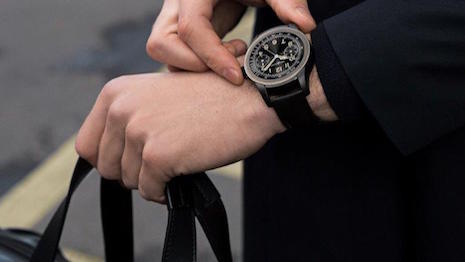 Cartier has some of the most differentiated ecommerce services, according to DLG. Image credit: Cartier
Cartier has some of the most differentiated ecommerce services, according to DLG. Image credit: Cartier As consumers grow more comfortable buying luxury timepieces online, brands are catching up to shoppers’ ecommerce interest with direct-operated digital buying experiences.
A new report from Digital Luxury Group that analyzes 62 brands found that 40 percent have their own ecommerce store. While online shopping capabilities are becoming more commonplace, watchmakers have the potential to more thoroughly connect their physical and digital retail experiences.
"Luxury watch brands are slowly catching up when it comes to direct-to-consumer ecommerce," said Christopher Peterson, head of data and analytics at Digital Luxury Group, Geneva, Switzerland.
"But the few of them who are ahead – Richemont and LVMH – who have decided to speed up their online strategy, are widening the gap," he said.
"More than just selling online, their direct-to-consumer approach allows them to significantly grow their knowledge on consumers, grasp fast-changing behaviors, adapt services on a client-centric basis, and overall master the customer experience, from online to offline."
Online service
On average, watch brands sell to 13 markets. Brazil, Russia and India are among the nations that are commonly left out of distribution, despite their position as key emerging luxury markets.
While 80 percent of brands that offer ecommerce sell to the United States and the United Kingdom, only 41 percent operate their own online store in China.
Of the brands studied, Montblanc has the widest ecommerce reach, selling to 54 markets. The German label was an early ecommerce adopter, having rolled out a direct-operated online store in 2011.
Montblanc has the widest global reach for its ecommerce site. Image credit: Montblanc
Fellow Richemont-owned brand Cartier was deemed by DLG as having the most differentiating ecommerce functions.
Cartier enables consumers to chat with a sales associate and view item availability. DLG found that only 5 percent of brands warn consumers on a product page that a product is about to go out of stock, and 15 percent offer the chance to be notified by email when it becomes available again.
The brand also differentiated itself as one of the only houses to offer alternative payment methods, with Alipay and WeChat Pay capabilities.
Six in 10 luxury watch brands allow shoppers to buy merchandise online and pick it up in store. About 30 percent are also giving the option to check local in-store availability on an item.
While picking up online orders is fairly common, online purchases can often not be returned to the store, with only 45 percent offering in-store returns on ecommerce orders.
Luxury watch brands often leverage videos on their Web sites to portray craftsmanship or offer insight into their house. However, only 45 percent currently embed video on product pages, where it can add context to descriptions and images.
Watch brands do not offer reviews. Image credit: WatchBox
Some aspects of online shopping that are common in categories such as fashion have not translated to watch brands’ ecommerce sites. For instance, shoppers cannot leave reviews or buy gift cards online through any of the indexed brands.
DLG notes that the brands that are most sophisticated tend to be part of a conglomerate or a company that sells merchandise across multiple categories. This enables them to learn from brands in beauty or apparel, who have been running ecommerce operations for longer.
Social shopping
About half of the watch brands that have ecommerce in place have some form of social shopping available to consumers, such as buying through Facebook or Instagram.
In 2017, Swiss watchmaker Omega turned to Instagram to facilitate sales of a newly released, limited-edition timepiece.
For the first time, Omega offered online sales of its timepiece, the Omega Speedmaster “Speedy Tuesday,” also the moniker of its Instagram sales promotion. In the past, watch brands have been hesitant to embrace online selling, but recently watchmakers have launched campaigns that emphasize social commerce (see story).
Some labels that do not offer ecommerce leverage shopping tools on Instagram or Facebook to direct consumers further down the purchase path, allowing them to find out more product information or a boutique.
Even if watch brands themselves are not selling directly online, they are increasingly partnering with multi-brand retailers to offer a digital buying experience.
The luxury buyer has shown a willingness to spend online, and Yoox Net-A-Porter Group noticed a need for more jewelry availability in ecommerce, leading it to launch hard luxury hubs on its Net-A-Porter and Mr Porter platforms.
Among the items sold through Mr Porter was a $480,000 Bell & Ross timepiece (see story).
Similarly, online luxury platform Farfetch took a major step into the world of hard luxury with the launch of two online hubs partnering with some of the biggest brands in jewelry.
Fine jewelry and fine watches now each have their own separate hubs online on Farfetch’s platform. Jewelers from Chopard to Tiffany & Co. to David Yurman joined Farfetch for the first time, bringing some of the biggest names in luxury jewelry together in one online marketplace (see story).

